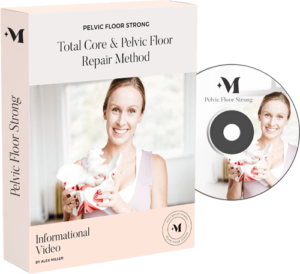Welcome to Linkingo’s complete guide on pelvic floor exercises when pregnant! As you know, many people consider pregnancy an ideal period to sit back and relax. However, it is the time when your body is more vulnerable to fatigue than usual; your back is aching from carrying extra weight. We understand that it might be challenging to start doing pelvic floor exercises, especially if you have never worked out before. But hear me out, just sitting around is not beneficial for you and your baby!
When you are pregnant, your pelvic floor has to bear much pressure. It might have to go under more strain during childbirth. The pelvic floor is, in fact, a combination of muscle layers that stretch like a supportive hammock from the public bone (in front) to the end of the backbone (spine). If those muscles are not flexible enough, there is a chance your body might not be able to cope with the weight of the baby. It makes the delivery process harder and, in some cases, might even lead to vaginal tearing. The most common consequence of a weak pelvic floor is stress incontinence which occurs after childbirth.
For that reason, every pregnant woman should perform pelvic floor exercises, regardless of age. It not only keeps yourself and the baby safe but also delivers much more benefits to your overall health, mood, and even body shape!
Can You Do Pelvic Floor Exercises While Pregnant? What Are The Benefits?
Absolutely yes. However, people often think of internal ones when it comes to pelvic floor exercises. Kegels and Squeeze And Release are the two most notable examples. However, as Linkingo has mentioned in our previous post, they can be much more than that. You can use some whole-body movements to strengthen your pelvic floor muscles. If you choose suitable exercises and practice them correctly, they can:
- Reduce back pain. When you are pregnant, it is natural that the ligament becomes softer and more vulnerable to prepare for your labor. It adds more pressure to your lower back and pelvis joints, which results in back pain. Some pelvic floor exercises can work with your lower back and reduce the strain, making it more relaxed and comfortable.
- Since exercises stimulate your bowels, they can reduce constipation, bloating, and swelling.
- A few physical activities can boost your mood and energy level. Pelvic floor exercises for pregnant women are no exception. Furthermore, it helps you sleep better.
- Though most pelvic floor exercises for pregnant women are light, they still help you prevent excessive weight gain, promote muscle tone, and improve your endurance.
So, are you inspired to stand up and start exercising? With the many benefits it can bring to both you and your little one, are you eager to begin immediately? If so, Linkingo will reveal all the things you need to get the most out of pelvic floor exercises When pregnant below. However, before that, there are a few things you have to take note of.
What Precautions Should You Take Before Doing Pelvic Floor Exercises When Pregnant?
Here are the things you have to be very aware of before and during performing pelvic floor exercises. Read carefully, and do not miss a single word. Keeping them in mind will significantly lower the risk of damaging yourself and your baby.
- If you attempt to do both internal and whole-body pelvic floor exercises, wearing a sports bra will make it much more comfortable for you. Furthermore, it also protects your breasts. In later stages of pregnancy, you might want to wear a belly support belt to reduce the discomfort while performing movements.
- Before doing any full-body exercise, don’t forget to warm up and cool down afterward. Warming up lowers the chance of injuring yourself as it loosens your joints and improves blood flow to your muscles. That way, your muscles are less likely to rip, tear, or twist during exercising. Don’t forget that some of the muscles, especially those in your lower back, become a lot more vulnerable when you are pregnant. Hence, warming up becomes imperative.
- Drink plenty of water before, during, and after the session.
- If you have never exercised before, you should not take up a strenuous routine at once. As you get used to it, you can lengthen it gradually.
- Remember not to exhaust yourself. As you are pregnant, it is common to suffer from pregnancy fatigue. You might find yourself not as consistent and flexible as you were, which is perfectly normal. It is okay to slow down and take some rest.
- Maintain a daily basis. Just like any muscle in our bodies, pelvic floor muscles require persistence to be improved. Any amount is better than nothing.
- Avoid becoming overheated, especially during the first trimester. Do not perform exercises outside when the weather is too hot or humid.
Aside from those above, please note that women with these conditions should avoid doing full-body pelvic floor exercises:
- Heart or lung diseases.
- Cervical cerclage.
- Being pregnant with twins or more and at risk of preterm labor.
- Placenta previa.
- Preeclampsia.
- Severe anemia.
If you fall into one of these groups, you may still perform some internal ones to strengthen your pelvic floor muscles. However, please consult your doctor or physician to make sure.
When Should I Start Doing Pelvic Floor Exercises When Pregnant?
It is often assumed that during and after pregnancy are the most critical time to start training your pelvic floor. However, when it comes to training these muscles, the sooner, the better. Exercising them even before falling pregnant can lessen the damage your muscles have to take after carrying a growing baby. Furthermore, it lowers the risk of injury during vaginal birth and accelerates the recovery progress afterward.
Therefore, if you plan to get pregnant soon, doctors and health experts recommend that you begin now. Still, if you have been pregnant for a few weeks or few months, it is never too late to start. No matter which stage of pregnancy you are at, there will still be exercises that are suitable for you.
So, What Are The Best Pelvic Floor Exercises During Pregnancy?
Now, let’s take a look at five recommended pelvic floor exercises when pregnant:
1. Kegels.
Kegels is an exercise specifically designed to support the muscles that hold your bladder, uterus, and bowels. As you improve these muscles during pregnancy, you can develop the ability to relax and control them while giving birth.
To perform this exercise, imagine that you are trying to stop the flow of urine. When you do this, you are contracting and relaxing your pelvic floor muscles. That’s what Kegels exercise is all about. However, despite it being familiar and straightforward, Kegels is not for everyone. To see whether this exercise is proper for you or not, check out Linkingo’s guide on the Kegel exercises.
2. Tailor Exercises.
Tailor exercises are effective in boosting the strength of your pelvic, hip, and thigh muscles. Furthermore, it also helps reduce back pain. There are two types of tailor exercises:
- Tailor sit: Sit comfortably on the floor while keeping your knee bent and ankles crossed. Then, slowly lean forward but still maintain a straight back. You can practice this position any time throughout the day.
- Tailor press: Sit on the floor while keeping your knee bent and stick the bottom of your feet together. Next, grasp your ankles and pull your feet slowly toward the body. Inhale, then press your knees down against your hands. Raise your hands up against your knees. Keep the position for five seconds.
3. Belly Breathing.
This exercise is simple, risk-free, and effective in strengthening your abs as well as the pelvic floor. It also helps lower the risk of incontinence later.
All you have to do is sit with your legs crossed and the lower back supported. Keep your hands on your belly. Let your back and shoulders stay still. Then, slowly use your nose to inhale as you expand your belly. Exhale through your mouth, draw in your abdominals, and bring your navel toward your spine.
4. Belly Dance On All Four.
The fourth exercise works to strengthen your pelvic floor, abdominals, back, and lower body.
To perform this exercise, begin by getting down on your hands and knees. Keep your wrists under shoulders and knees hip-width apart. Keep your back flat, draw your abdominals up and in, press your navel towards the spine. Hold the position for a few seconds while breathing normally. Tilt your pelvis under and bring your public bone toward your navel. Then, please keep it for 5 seconds.
5. Pelvic Tilt.
This, along with Kegels, is the most recommended exercise for pregnant and postpartum women.
First, lie on your back and keep your knees bent. Then, flatten your back against the floor by tightening the abdominal muscles and bending your pelvis up slightly. Stay in the position for 10 seconds.
How Much Should You Exercise During Pregnancy?
Doctors and experts would recommend an ideal routine of at least 150 minutes of light-moderate pelvic floor exercises per week for pregnant women. It is best to combine both internal exercises that focus only on your pelvic floor muscles and whole-body movements in which you move many muscles rhythmically. Combining both types not only help you better improve your pelvic floor strength but also improve your blood circulation, relax your lower back, and work with your bowel to reduce pains or cramps during pregnancy.
Light to moderate intensity means you are exercising just enough to increase your heart rate and start sweating. As a rule of thumb, you should maintain a conversation while you are exercising, but you cannot sing. If you find yourself breathless, you probably are overdoing it and need to adjust your routine immediately.
You can divide the 150 minutes into a 30-minute training session five days a week or break it down into 10 minutes each day. For those who do not familiarize themselves with pelvic floor exercises for pregnant women before, though, it might be challenging to maintain such a routine at first. You can start slow as you feel comfortable and gradually lengthen the time and intensity once your body gets used to it.
At first, you might begin with around 5 minutes a day. When you feel comfortable, you can add 5 more minutes every week until you hit 30 minutes a day.
Body Changes That Affect Exercise During Pregnancy.
During pregnancy, your body might have to go through many changes. First and foremost, your joints might become more vulnerable, which leads to the vulnerability of some muscles as well. Hence, you tend to be fatigued faster than usual.
The second change is your equilibrium. As you are pregnant, your center of gravity changes from the excess weight in the front and your shifting hips. The nearer you are to the due date, the more your body balance is affected. This extra weight makes it harder for you to perform movements.
All of these factors influence the way you exercise and what pelvic floor exercises you choose. You might consult your doctor or physician to determine the best way to practice according to your specific situation.
Why Is It Important To Keep Doing Pelvic Floor Exercises After You Deliver?
As mentioned, doing pelvic floor exercises can speed recovery progress, helping you heal faster after childbirth. What’s more, it prevents incontinence and saves you from the risk of prolapse, which is higher in post-pregnancy women. It also makes sex better, prevents the risk of pelvic floor dysfunction as you age, and improves your overall health.
Generally, all the recommended pelvic floor exercises during pregnancy are safe and straightforward to follow. However, it would still depend on each woman’s health and pregnancy state. Therefore, you should consult a doctor or physician to find out the most suitable set of exercises before practicing.
While doing pelvic floor exercises when pregnant, there is a chance that you might make mistakes without noticing. They include wrong breathing techniques or false exercising posture. No matter what it is, it will slow down the training progress and even affect your muscles. Getting a personal guide is an ideal option, but not everyone can do that due to financial reasons and so on.
In that case, we highly recommend you check out:
The Pelvic Floor Strong by Alex Miller.
The program is a set of videos containing the most straightforward and practical pelvic floor exercises for women. In these videos, Alex, a health specialist and fitness expert will guide you through each step. The best thing about Pelvic Floor Strong is all the exercises are very light and easy, targeting women of all ages. If you are pregnant, you can also find many suitable exercises for you here. The important thing is, this program still works for you even after childbirth. It is like having a personal trainer at your house!

>>> Click Here To Get Instant Access <<<
Pelvic Floor Strong is the program Linkingo has spent many hours examining and experiencing before recommending our dear readers. Therefore, we can assure you of the quality of this product. You can learn more about the program by reading our comprehensive review on Pelvic Floor Strong. Here, you will find everything you need to know about the program. I’m sure that this is the most detailed review on Pelvic Floor Strong you can find.
Our Final Thoughts
It comes to the end of our guidelines for doing pelvic floor exercises when pregnant. Remember, before doing any activity, you and your baby’s safety should come first. As long as you keep all of these things in mind, training would be risk-free and valuable.
Find this article helpful? Please share it with those in need because sharing is caring! Your feedback helps Linkingo improve our website, so if you like to share your opinion, please leave a comment below!
We look forward to seeing you in our next posts!






Leave a Reply